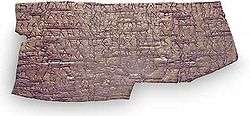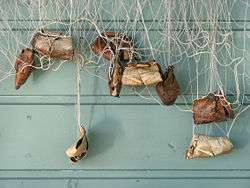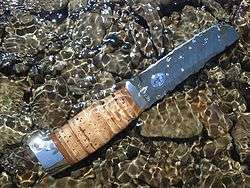Birch bark
Birch bark or birchbark is the bark of several Eurasian and North American birch trees of the genus Betula.
The strong and water-resistant cardboard-like bark can be easily cut, bent, and sewn, which has made it a valuable building, crafting, and writing material, since pre-historic times. Even today, birch bark remains a popular type of wood for various handicrafts and arts.
Birch bark also contains substances of medicinal and chemical interest. Some of those products (such as betulin) also have fungicidal properties that help preserve bark artifacts, as well as food preserved in bark containers.

Collection and storage
Removing birch bark from live trees is harmful to tree health and should be avoided. Instead, it can be removed fairly easily from the trunk or branches of dead wood, by cutting a slit lengthwise through the bark and pulling or prying it away from the wood. The best time for collection is spring or early summer, as the bark is of better quality and most easily removed.
Removing the outer (light) layer of bark from the trunk of a living tree may not kill it, but probably weakens it and makes it more prone to infections. Removal of the inner (dark) layer, the phloem, kills the tree by preventing the flow of sap to the roots.
To prevent it from rolling up during storage, the bark should be spread open and kept pressed flat.

Working

Birch bark can be cut with a sharp knife, and worked like cardboard. For sharp bending, the fold should be scored (scratched) first with a blunt stylus.
Fresh bark can be worked as is; bark that has dried up (before or after collection) should be softened by steaming, by soaking in warm water, or over a fire.
Uses



Birch bark was a valuable construction material in any part of the world where birch trees were available. Containers such as wrappings, bags, baskets, boxes, or quivers were made by most societies well before pottery was invented. Other uses include:
- In various Asian countries (including Siberia) birch bark was used to make storage boxes, paper, tinder, canoes, roof coverings, tents, and waterproof covering for composite bows, such as the Mongol bow, the Chinese bow, Korean bow, Turkish bows, Assyrian bow, the Perso-Parthian bow...etc. It is still being used. More than one variety of birch is used.
- In North America, the native population used birch bark for canoes,[1] wigwams, scrolls, ritual art (birch bark biting), maps (including the oldest maps of North America[2]), torches,[3] fans, musical instruments, clothing, and more.
- In Scandinavia and Finland, it was used as the substratum of sod roofs and birch-bark roofs, for making boxes, casks and buckets, fishing implements, and shoes (as used by the Egtved Girl).
- In Russia, many birch bark manuscripts have survived from the Middle Ages.
- Birch bark knife handles are popular tools to be made currently.
- In India, birch-bark, along with dried palm leaves, were the primary writing supports before the widespread advent of paper in the second millennium CE.[4] The oldest known Buddhist manuscripts (some of the Gandharan Buddhist Texts), from Afghanistan, were written on birch bark.[5]
- Neanderthals used birch bark to make a tar adhesive through the process of dry or destructive distillation[6] [7].
Birch bark also makes an outstanding tinder, as the inner layers will stay dry even through heavy rainstorms.
References
- Tom Vennum, Charles Weber, Earl Nyholm (Director) (1999). Earl's Canoe: A Traditional Ojibwe Craft. Smithsonian Center for Folklife Programs and Cultural Studies. Archived from the original on 2013-01-04. Retrieved 2012-12-03.
- Hayes, Derek. Historical Atlas of Canada: Canada's History Illustrated with Original Maps. Vancouver: Douglas & McIntyre Ltd, 2002. p. 152.
- Boszhardt, Robert F. (2003). Deep Cave Rock Art in the Upper Mississippi Valley. St. Paul: Prairie Smoke Press. pp. 54–55. ISBN 0-9704482-3-6.
- P., Losty, Jeremiah (1982). The art of the book in India. British Library. Reference Division. London: British Library. ISBN 0904654788. OCLC 8653520.
- Salomon, Richard; Barnard, Mark; Allchin, Frank Raymond (1999). Ancient Buddhist scrolls from Gandhāra: the British Library Kharoṣṭhī fragments. London: The British Library. ISBN 0712346112. OCLC 263439456.
- Kozowyk, P. R. B.; Soressi, M.; Pomstra, D.; Langejans, G. H. J. (2017-08-31). "Experimental methods for the Palaeolithic dry distillation of birch bark: implications for the origin and development of Neandertal adhesive technology". Scientific Reports. 7 (1): 8033. doi:10.1038/s41598-017-08106-7. ISSN 2045-2322. PMC 5579016. PMID 28860591.
- Schmidt, P., Blessing, M., Rageot, M., Iovita, R., Pfleging, J., Nickel, K. G.; Righetti, L. & Tennie, C. (2019). "Birch tar extraction does not prove Neanderthal behavioral complexity". PNAS. 116 (36): 17707–17711. doi:10.1073/pnas.1911137116. PMC 6731756. PMID 31427508.CS1 maint: multiple names: authors list (link)
- The Algonquin Birchbark Canoe, by David Gidmark.
Further reading

- McPhee, John, The Survival of the Bark Canoe, Farrar, Straus and Giroux, New York, 1975.
- Adney, Edwin Tappan and Howard Chapelle, Bark Canoes and Skin Boats of North America, Skyhorse Publishing, Inc., 2007, 2014.
- Jennings, John, Bark Canoes: The Art and Obsession of Tappan Adney, Firefly Books Ltd., 2004.
- Behne, C. Ted, editor, The Travel Journals of Tappan Adney, 1887-1890, Estate of Tappan Adney, 2010.
- Goode, F.W., Ojibwe Birch Bark Canoes: Anishinaabe Wigwassi-Jiimaan, Beaver Bark Canoes, 2012.
External links
| Wikimedia Commons has media related to Betula (bark). |
- Birchbark articles from the NativeTech site.
- Birch and Birch Bark, an article by John Zasada at a University of Minnesota site.
- Birch Bark Canoe page on the site of the Algonquins of Pikwàganagàn.
- César's Bark Canoe—Watch a documentary on how to build a Birch bark canoe
- Bureau of Catholic Indian Missions Digital Image Collection at Marquette University; keyword: birch bark.
- Wiigwaasi-Jiimaan: These Canoes Carry Culture—Short documentary featuring the building of an Anishinaabe-Ojibwe birchbark canoe in Wisconsin.